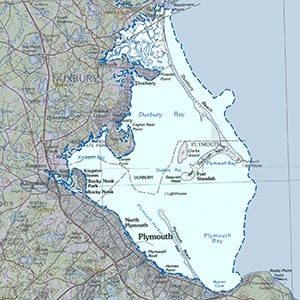Important Bird Area Sites in Massachusetts
Important Bird Area: Plymouth and Duxbury Bays
Site Summary
Nominated By
Kathleen Anderson
Size
20,362 acres
Towns and Counties
Duxbury, Kingston, Marshfield, Plymouth
Ownership
municipal, private, nongovernmental organization
Major Habitats
80% marine/tidal8% salt marsh7% coastal beach5% other (oak-conifer transitional forest, river/stream, urban/suburban, early successional shrubland, cultural grassland)
Land Use
nature & wildlife, conservation/ land trust, recreation, hunting & fishing, fisheries/aquaculture, undeveloped, suburban/residential, research
Serious Threats
predators, habitat conversion, disturbance to birds or habitat, recreational development/overuse
Minor Threats
invasive or non-native plants, introduced animals/feral pets, water/ air pollution, residential/commercial development
IBA Criteria
- Category 1: Sites important for long-term research and/or monitoring projects that contribute substantially to ornithology, bird conservation, and/or education.
- Category 2: Sites containing assemblages of species characteristic of a representative, rare, threatened, or unique habitat within the state or region.
- Category 4: Shorebirds: The site regularly supports 1,000 or more shorebirds at one time at a coastal site, during some part of the year, or a significant concentration of shorebirds at one time at a nontidal site. The designation "shorebirds" includes birds such as plovers, sandpipers, snipe, woodcocks, and phalaropes.
- Category 5: Waterfowl: The site regularly supports 500 or more waterfowl at any one time. The designation "waterfowl" includes birds such as loons, grebes, cormorants, geese, ducks, coots, and moorhens.
Site Description
The Plymouth Bay Complex, within the boundaries of Plymouth, Kingston, and Duxbury, is one of the state's largest natural embayments with approximately 10,233 acres of bay, 4,600 acres of mudflats at low tide, 800 acres of salt marsh, and 526 acres of beach. The total length of the shoreline is 55 miles, which includes 16 miles of barrier beach.
Current Conservation Status
Overuse of Plymouth and Duxbury beaches by four-wheel-drive vehicles is a major disturbance and threat to shorebirds, terns, and the federally listed Piping Plover. Erosion-control practices on beaches, such as the use of snow fence, discarded Christmas trees, and the planting of beach grass and other vegetation, pose threats to Least Tern and Piping Plover habitats. Mass Audubon and MassWildlife are working with the town governments to reduce these impacts.
Ornithological Significance
Listed species breeding include Piping Plover, and Roseate, Least, Common, and Arctic terns. The tern colony at the end of Long Beach has periodically supported 5,000 or more pairs of the four species of terns for the past 100 years. Up to 26 pairs of Piping Plovers, 5% of the state population, have nested on the site's barrier beaches. The heronry on Clarks Island has historically supported over 400 pairs of 6 species of egrets, herons, and ibis. The mudflats attract large numbers of migrant shorebirds (more than 1,000 annually), especially in late summer and fall. Waterfowl of many species winter in the harbor and just off the beaches. Migrant falcons, passerines, and thousands of Tree Swallows pass along the beaches in the fall. The site supports nearly 10% of state's coastal wintering American Black Duck (6,350, 1997). The area contains at least three regional breeding and/or wintering/migrant high conservation species. Thirty-four pairs of Saltmarsh Sharp-tailed Sparrows were counted during a Mass Audubon salt marsh survey in 2000.
Other Flora or Fauna of Significance
These bays, with their extensive salt marshes, tidelands, and Eelgrass beds, are major nurseries of marine fish, shellfish, horseshoe crabs, and other marine invertebrates. Several rivers entering the bays of this site, including Eel River, Town Brook, Jones River, Bluefish River, and the Green Harbor Creek, support spawning populations of anadramous and/or catadromous fish species, such as Alewives, Blueback Herring, Rainbow Smelt, and American Eel.
Data Sources
Clough, T. Brant Data. Manomet Center for Conservation Sciences files (fide Trevor Lloyd-Evans).
Harrington, B.A. Shorebird data from Manomet Center for Conservation Sciences.
Hecker, S. and B. Blodget. Piping Plover and tern data. MassWildlife and Massachusetts Audubon Society (personal communication).
Heusmann, H.W. 2001. Black Duck and Common Eider numbers (personal communication).
Iwanowicz, H.R., R.D. Anderson, and B.A. Ketscke. 1974. A study of the marine resources of Plymouth, Kingston, and Duxbury Bay. Monograph Series 17, Division of Fisheries, Dept. of Natural Resources, Commonwealth of Massachusetts.
Massachusetts Coastal Zone Management Plan - Chapter 5 of Vol. II. Massachusetts Coastal Regions and An Atlas of Resources.
Morrison, R. I. G. et. al. 2001. Estimates of Shorebird Numbers. Occasional Paper Number 104. Canadian Wildlife Service.
Veit, R.R and W.R. Petersen. 1993. Birds of Massachusetts. Massachusetts Audubon Society, Lincoln.
Records fromBird Observer, 1974-2000.




